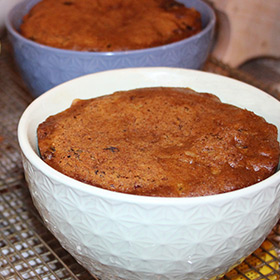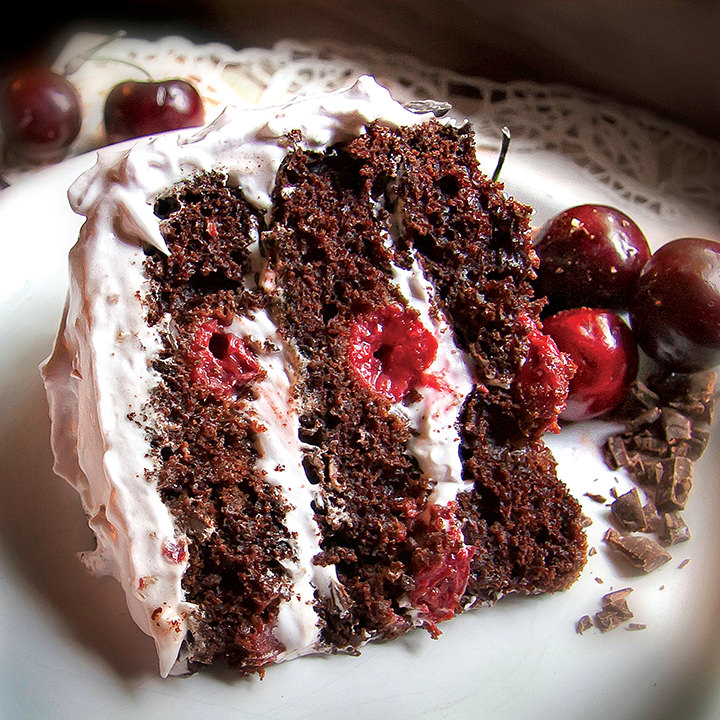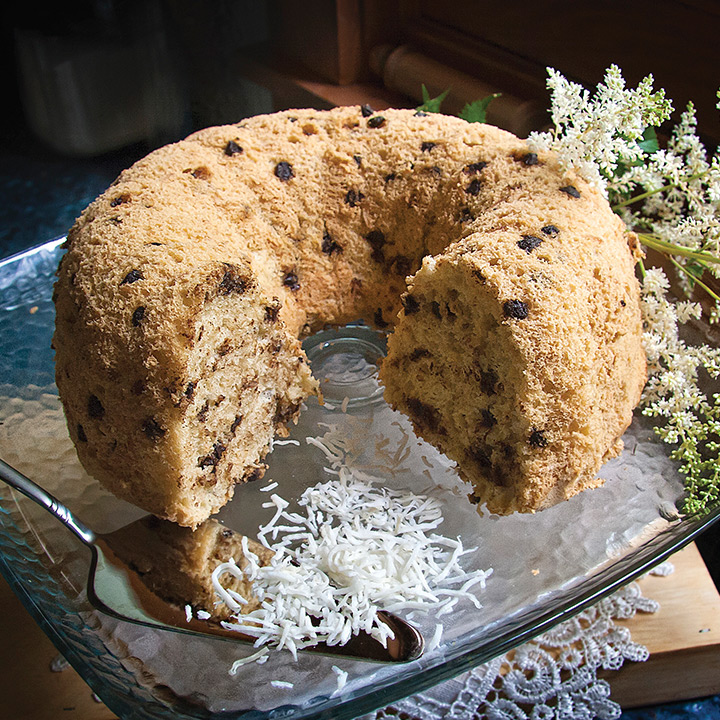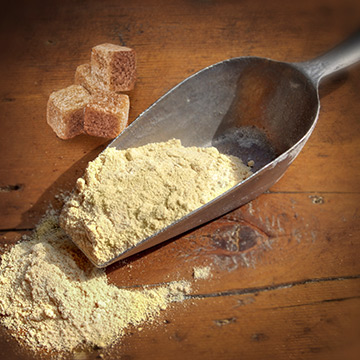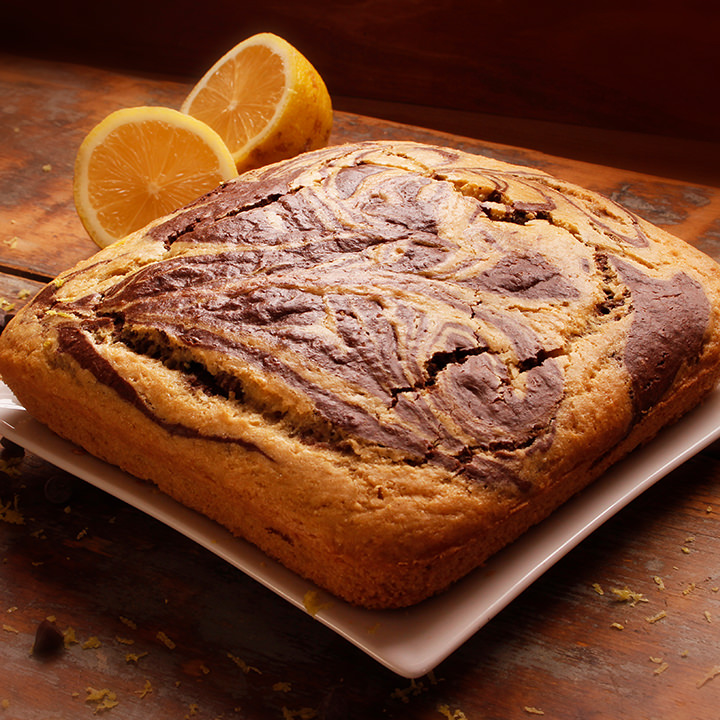Mother Marcelle's Christmas Pudding Recipe Gluten-free, dairy-free (casein-free) and hypotoxic
For the non-hypotoxic recipe: TRADITIONNAL VERSION.
By: Cuisine l'Angélique
PORTIONS: 15
ORGANIC INGREDIENTS
PUDDING :
- 3 large eggs (165 g)
- 180 g (1/2 cup) molasses
- 110 g (1 cup) light brown sugar
- 130 g beef tallow, very finely chopped or softened butter if you don't follow a diet excluding dairy products (measurement is given in grams for accuracy)
- 85 g (1/3 cup) strong coffee brewed in a percolator
- 2.5 ml (1/2 tsp) baking soda
- 420 g (3 cups) all-purpose flour "La Merveilleuse"
- 7.5 ml (1 1/2 tsps) baking powder
- 5 ml (1 tsp) salt
- 2.5 ml (1/2 tsp) ground cinnamon
- 2.5 ml (1/2 tsp) ground cloves
- 2.5 ml (1/2 tsp) ground nutmeg
- 320 g (2 cups) Thompson raisins
- 110 g (3/4 cup) dried Montmorency cherries
- 90 g (1/2 cup) dried prunes, chopped
- 75 g (1/2 cup) dried cranberries
- 50 g (1/2 cup) slivered blanched almonds
FLAMBE UPON SERVING:
- 65 to 125 ml (1/4 to 1/2 cup) Grand Marnier or Cognac, to taste and depending on the size of the pudding
ACCOMPANYING SAUCE:
- 220 g (1 cup) sugar
- 30 ml (2 tbsp) all-purpose flour "La Merveilleuse"
- 30 ml (2 tbsp) margarine or butter (if you don't follow a diet excluding dairy products)
- 500 ml (2 cups) boiling water
- 30 ml (2 tbsp) lemon juice, freshly squeezed
- 2.5 ml (1/2 tsp) lemon zest
- Grated nutmeg, to taste (about 2.5 ml (1/2 tsp) or more)
PREPARATION
You can prepare your pudding 2 to 3 weeks in advance and store it in the refrigerator.
- Grease a plum pudding pan with a total capacity of 2.5 litres (10 cups). See possible mould alternatives.
- Fill a large roasting pan with water halfway up, put a rack at the bottom then place the roasting pan across 2 burners of the stove, cover and bring the water to a boil and then turn off the heat. The pudding will steam in the roasting pan.
- In a medium bowl, using an electric mixer, beat the eggs. Add molasses and brown sugar and continue beating until creamy.
- Add tallow, coffee and baking soda. Mix gently with a whisk and let stand for 15 minutes. Note: If using butter, add butter first, beat with an electric mixer, then add coffee and baking soda and finish gently mixing with a whisk.
- Meanwhile, in a large bowl, combine flour, baking powder, salt and spices. Once the dry ingredients are well mixed, add the raisins, dried fruits and almonds and stir again, using a wooden spoon, so that all the ingredients are evenly distributed in the flour.
- Add the liquid mixture to the dry ingredients and mix well with a wooden spoon until the dough is uniform.
- Spread the dough evenly in the pan, pressing well, if necessary, with slightly wet fingers. The mould should not be filled more than 2/3 because the dough will swell when cooked. If your mould is not large enough for the entire amount of dough, use more than one mould (see other mould alternatives).
- Cover the mould with the lid or with 2 layers of aluminum foil, held in place by a tight elastic. The important thing is to create a seal that prevents steam from getting to the dough. Even if you have a proper lid for the pan, first put a layer of aluminum foil and then the lid; this optimizes the waterproofing.
- Bring the water back to boiling in the roasting pan. As soon as it comes to a boil, place the pudding pan in it. Water must reach 2/3 of the height of the mould; adjust as needed by adding or removing water. Cover, again bring to a boil then simmer over low heat (make sure the water really simmers). During cooking, check the water level and adjust as needed.
- Depending on the size of the pudding, the cooking time may vary from 1 to 3 hours. If you have divided the pudding into 3 moulds, check after 1 hour; If you have divided the pudding into 2 moulds, check after 1 hour and 30 minutes and after 2 hours if the pudding is in a single pan. The pudding will be ready when a toothpick inserted in the center comes out clean (the same principle as a cake but take care to not overcook).
- Allow the pudding to cool on a wire rack without unmoulding, but removing the lid or aluminum foil. To prevent the top from drying out too much, simply cover with a dry dishcloth.
- When cooled, unmould (make sure the pudding is not glued to the mould by gently passing the blade of a knife all around) and wrap in 2 layers of aluminum foil (to avoid aluminum contact, simply put waxed paper or parchment first). Keeps in the refrigerator for 2 to 3 weeks.
DAY OF SERVICE:
Remove from the refrigerator on the morning of the serving day, to bring to room temperature. Make the accompanying sauce.
ACCOMPANYING SAUCE:
- In a small saucepan, combine sugar and flour and mix well. Place margarine (or butter) on top.
- Add boiling water and whisk.
- Cook over medium-low heat, stirring constantly with a whisk until thickened. Then add the lemon juice, zest and nutmeg. Taste and adjust, if needed.
- If you want a slightly thicker sauce, simply add 15 ml (1 tablespoon) of organic cornstarch (blended in the same amount of water). Bring gently to a boil, stirring constantly, until thickened.
- Serve this hot sauce on the pudding.
TO SERVE:
- To serve, you will have to unwrap the pudding, put it back in the mould, and reheat it in the same way it was cooked (covering the top, of course).
- When the pudding is hot, turn it over on a serving plate. Bring the alcohol to a boil, pour it into a sauce dish (warm it up in hot water to avoid hot-cold contact). Flame the alcohol with a lighter, turn off the lights of the house... then gently pour over the pudding. The magic of this beautiful blue flame will amaze everyone!
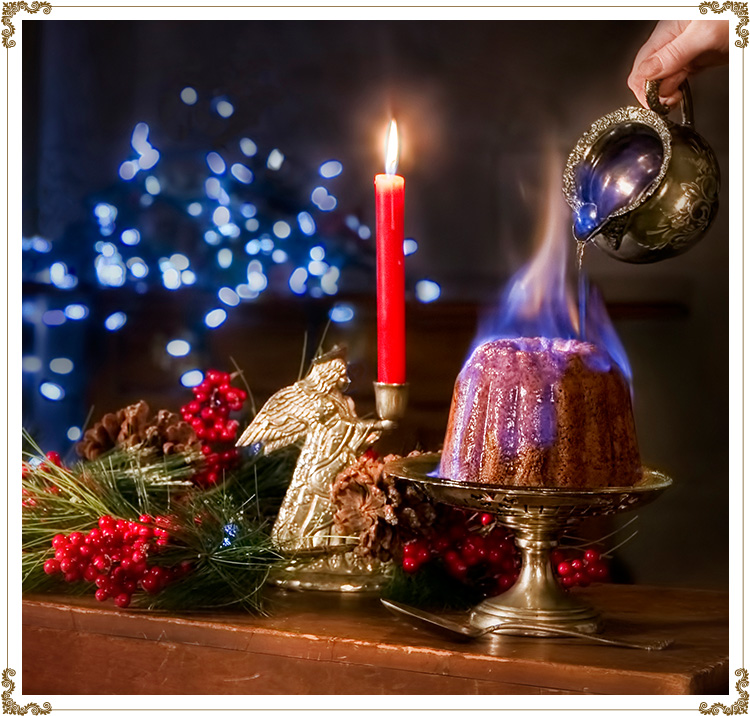
A traditional recipe of yesteryear that will thoroughly impress your guests! The magic of the beautiful blue flame will dazzle everyone!
A-Traditionally, this recipe was prepared with finely chopped beef tallow. If you want to use beef tallow, you can get it directly from your butcher. You can also use butter instead.
B-The dough in the traditional plum pudding mould
C-Pudding cooked in small ceramic bowls
D-Pudding once unmoulded
A nice gift idea
You can give this pudding as a gift! Simply wrap it in a double plastic wrap and offer it in the bowl used for cooking! You can give the recipe also to explain how it’s served.

MOULD ALTERNATIVES
A plum pudding mould with a total capacity of 2.5 litres (10 cups)
If you don't have a specific plum pudding mould, you can still make this recipe!
Simply use one of these alternatives:
- A large ceramic bowl
- 2 to 3 ceramic bowls
- 2 empty coffee cans
Note: You will need one or more containers with a total capacity of 2.5 litres (10 cups).
And there you go, you can prepare this tasty recipe!
A MATTER OF TRADITION
Mother Marcelle's Christmas Pudding
This unique dessert recipe that we’re sharing with you today pays tribute to the beloved lady responsible for transmitting this tradition. In Ms. Beauregard's family, this prized delicacy passes from generation to generation as a precious legacy, from the Irish great-great-grandmother Noonan who once carried one in her luggage from the United Kingdom.
Mother Marcelle's Christmas Pudding is a family recipe for the famous Plum Pudding steamed in a classic mould, then flambéed with Grand Marnier when serving. It is always a special moment of the Beauregard family's Christmas dinner when, with the lights out in the dining room, the beautiful diaphanous blue flame dances atop this generous dessert. And it is the silence, the emotion of the moment, the return of childhood memories... A tear sometimes flows, then the smiles become contagious little by little and as the flame gently ends its luminous dance atop the pudding, the chirping of all again expresses shared joy.
A legendary tradition
Christmas Pudding is a British or Irish version of the famous Plum Pudding cooked all over Europe. Composed of flour, dried fruit, nuts, kidney fat, brown sugar and molasses to which one adds a citrus juice and an alcohol of your choice whether cognac, brown beer or rum, the mixture is prepared several days, or even up to five weeks in advance during the Stir-Up Sunday. Some will even hang it in a cloth or, as in older times, in a lamb or beef stomach, in order to refine its taste during all these weeks by regularly wetting it with alcohol.
History Page
The first puddings date back to the Middle Ages, in the 1420s. At that time, their use was not as a dessert, but rather a way to preserve meats: in cake moulds covered with dried fruit and soaked in wine as preservatives. The puddings then consisted of veal, mutton or candied chicken meat and dried fruit to which vegetables, pieces of bread, spices and sometimes raw sugar were added. The advent of better preservation methods meant that pudding meats were gradually squeezed out by sweet ingredients to make a proper dessert. Long associated with the harvest festival, the recipe became an increasingly popular dish at Christmas, so that it was eventually named Christmas Pudding especially in England. It was at the time of Queen Elizabeth I (1558 to 1603) that the famous dish was named Plum Pudding when the great lady's cooks came up with the idea of adding prunes to the mix.
Fun ritual
The tradition of Christmas Pudding is that the mixture prepared five weeks before consumption is stirred in turn by each member of the family while making a wish. Some even hide coins to bring good luck to those who find them when... they don't break a tooth!


